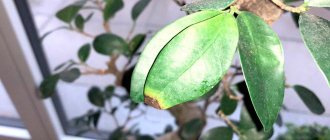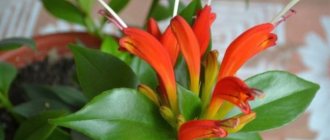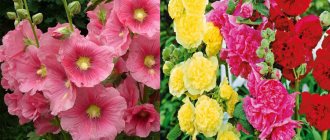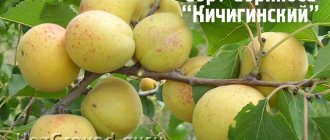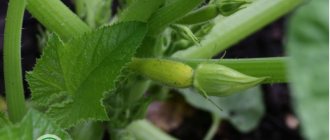- January 21, 2019
- Flowers
- ROME.
Globular chrysanthemums are a decorative variety of plants that are used to decorate loggias, flower beds, and verandas. These flowers look perfect in group plantings. They are easy to care for, although they have their own nuances, including low frost resistance. Despite this, planting chrysanthemums in open ground and caring for them are comprehensible tasks for connoisseurs of beautiful plants.
General classification of chrysanthemums
Chrysanthemums come in many different types. They are divided according to flowering time, stem type, and bush height.
According to the timing of flowering, plants are divided into early, middle and late varieties. The latter bloom in November, the middle ones in October, and the early ones in September.
The earliest varieties to bloom are:
- "Anita" - blooms with a spherical white flower. It is very large, can reach a diameter of 20 cm.
- “Lilac bislet” is a spherical flower of lilac color.
- "Blanka."
- "Broadway", "pearl".
- "Kremist."
- "Milka."
- "Resolute".
- "Shlef-Purple."
- "Kornikova".
- "Regalia".
All the varieties presented above are large-flowered. They have huge flowers, reaching a size of 18-20 cm. The bushes themselves reach a height of about 90 cm. Most often, chrysanthemums are grown to create bouquets. Huge flowers with a diameter of up to 18 centimeters or more are formed on the stem. The corollas of the petals are flat, tubular, thick. Depending on the type of petals, the flowering period is determined. It usually lasts from September until the New Year. To preserve the beauty of the flowers, they are carefully removed from the soil, replanted and harvested before the end of October.
Small-flowered varieties can have double or simple flowers with a diameter of about 9 cm. Among the small-flowered varieties, the “Santini” hybrid, obtained by Dutch breeders, is distinguished. The variety is a plant with small flowers of about 5 cm. Up to 30 or more flowers bloom simultaneously on one bush. A distinctive feature of the variety is its decorativeness and compact root system, which is why it is grown in a container.
According to height, tall, low and medium-sized plants are distinguished. The tall ones include large-flowered varieties and single small-flowered ones. They are characterized by a well-developed bush, which requires strengthening with supports, and large inflorescence sizes.
Popular representatives of large-flowered varieties are the varieties “minx”, “tamara”, “lilac fog”. They have flowers from seven to ten centimeters, of different shades.
Low-growing species occupy a special place in landscape design. They are often used as border plants. These varieties are formed in the form of a ball strewn with bright flowers of various colors. Popular types of low chrysanthemums are “talisman”, “gels”, “ausma”, “multiflora”.
Medium varieties come in a variety of colors. They can have simple and double flowers. This species has flowers with a diameter of about seven centimeters. Unlike border varieties, medium-growing varieties are used as cut flowers. Popular varieties include Umka, Mirage, Princess Diana, and Bronze Crown.
Chrysanthemum varieties based on inflorescence size and flower structure
All varieties of garden chrysanthemum are combined into groups according to certain characteristics and characteristics. Plants can be either dwarf or giant. Height varies from 15 cm to 1.5 m. Thanks to the variety of shapes, sizes, and colors of inflorescences, you can create a stunning, colorful landscape.
Large-flowered chrysanthemums
Large flowers of various colors on strong long stems are ideal for making compositions and bouquets. They belong to the Astrov family, have a thickened root system, and highly branched shoots. The leaf blade is large - 20 cm long, 10 cm wide. The shape of the edges is wavy without jagged edges.
Large flowers can remain single or form multiple inflorescences with a basket diameter of up to 30 cm. Flowers can be anemone-shaped, spherical, hemispherical, with simple, ray-shaped, spider-shaped, curly-bent inflorescences. The variety produces little seed material, so propagation by division is preferable bush.
The main advantage of large-flowered chrysanthemums is their excellent external appearance. A huge selection of shades allows you to create beautiful compositions from different species, combining them with other small, tall shrubs. Most varieties bloom for more than 3 months and are frost-resistant. Flowers do not tolerate excessively wet soil, lack of heat and sun, and are susceptible to fungal diseases.
Medium-flowered varieties
They can be grown in open ground, in flower beds or in pots, as decoration for terraces and balconies. The height of the stems is 50-70 cm, the diameter of the flowers is up to 18 cm. The inflorescences are needle-shaped, flat or rolled into a tube. More often they are used to decorate the site. Popular varieties: Golden Fleece, Champagne Splash, Pink Chamomile.
Decorative indoor chrysanthemums with medium colors require some care. The pots must be periodically taken out into the fresh air and placed in the shade. They do not require frequent watering; moisture feeding can be replaced by spraying. To prevent the plant from losing its decorative appearance, it is necessary to regularly pick off dried stems and faded buds.
Small-flowered varieties
Compact small-flowered varieties grow in low bushes. Most of these species were bred in Korea, so they were separated into a separate group of hybrids - Korean chrysanthemum. Perennials quickly take root in open ground and individual pots. They are used for garden decoration, as indoor plants.
The height of the border variety does not exceed 30 cm. Medium-sized flowers can grow up to 50 cm. Tall representatives of the group are rare. They are grown for cutting to create bouquets and gift arrangements. Small-flowered inflorescences are 2-5 cm. Based on the shape of the bud, they are divided into the following types:
- Pompons with a hidden inflorescence;
- Terry with petals;
- Simple, reminiscent of chamomile.
Small-flowered chrysanthemums with a spherical crown look very neat and are indispensable when creating the design of a site. The flowers amaze with their abundance of colors. Unusual colors - burgundy, black, orange will become a real highlight of the flowerbed. Low bushes are often called oaks, due to the similar shape of the leaves to the centuries-old tree.
Description
Today, many different hybrids with unusual colors have appeared. Planting a spherical chrysanthemum and caring for it requires knowledge of the characteristics of plants.
The spherical chrysanthemum is a subshrub of the Asteraceae family. It has light green leaves, arranged alternately, with a simple shape and pronounced, clear serrations. The plant is able to independently take on a rounded, beautiful shape, without any additional trimming. The top of the cap is decorated with flowers that hide the foliage. They are grouped into baskets. The flowers are multi-tiered, most often double. After flowering, an achene is formed.
Caring for and planting chrysanthemums in open ground depends on the plant variety, since they have external differences in flowering time, bush height, and frost resistance. Globular varieties can reach a height of 80 cm. Flowering occurs in different periods - some bloom in August, and some in October.
Varieties and varieties
Globular chrysanthemums vary in stem height. They are usually divided into:
- Short or dwarf - from 18 to 35 centimeters.
- Medium-sized - from 35 to 55 centimeters, for example, Knopa.
- Tall - from 55 to 70 centimeters, these include the Ida variety.
Medium-sized varieties are considered the most widespread. They look great in various garden arrangements and grow well in open ground. Low-growing ones are used to decorate flower beds and are planted in pots on loggias and balconies. The tallest species are most often chosen for planting in the back row of alpine slides or flower beds.
Globular chrysanthemums are also distinguished by their flowering period:
- Early flowering - flowering period occurs in August.
- Medium flowering - delight with bright colors in September.
- Late-blooming - the inflorescences of these varieties bloom in mid-autumn.
The most common variety is Multiflora. It belongs to the medium-growing and medium-flowering species and has a rich color palette.
Chrysanthemum photo
If desired, you can select types of chrysanthemums for planting in the garden so that they will decorate the area from late summer until the first frost.
Globular chrysanthemums combine well in flower beds with many other flowers and look impressive when planted alone. Tall varieties combine better with neighbors that achieve similar shoot growth or with coniferous trees. Low-growing flowers in open ground are used to frame borders or beds, to create boundaries of certain areas of the garden.
The range of different shades of color includes about 3,500 options. Against the background of lawn grass, white or yellow inflorescences are the most advantageous.
Features of care
Planting and caring for spherical chrysanthemums is carried out in compliance with certain rules. First you need to prepare the place where you plan to grow the plant. Hybrid varieties prefer nutritious soil with sunlight. Planting and caring for garden chrysanthemums begins with choosing shoots that allow you to preserve all varietal qualities.
Planting spherical chrysanthemum
When grown from seeds, chrysanthemums lose their varietal properties, so these flowers are planted as shoots. A place for the plant must be chosen that is illuminated. In the shade, the flower can stretch out and change the timing of flowering. Chrysanthemum prefers nutritious and loose soil. In addition, good drainage will also play an important role in the development of the plant.
Globular chrysanthemums propagate by cuttings
It is best to plant cuttings on days when there is no sun. If this is not possible, then for several days after planting it is advisable to shade the plant a little, but in such a way that the shelter and cuttings do not touch. The shoots are planted in holes up to 40 cm deep. The hole must be well watered, a drainage layer must be laid and covered with a mixture of soil and vermicompost in a ratio of 20:1. There is no need to deepen the sprouts excessively.
Advice. If you are planting a tall variety, then take care of the support.
Choosing a place
For flowers, choose a sunny place, since the shade helps to stretch the shoots and sparse flowering. When choosing a location, you should take into account the high sensitivity of plants to moisture. Because of this, it is worth planting bushes where there is no stagnant water, there is drainage and drainage.
Planting and caring for garden chrysanthemums involves planting the plant in nutrient-rich soil with good drainage. Before planting the bush, the bed is enriched with peat and humus, but not too much, otherwise excess fertilizer will negatively affect flowering.
Growing rules
There is nothing complicated in planting and caring for spherical chrysanthemums - these are very unpretentious flowers. The only difficulty is preparing the Multiflora for the winter. The wintering method is largely determined by the climatic conditions of a particular region and can be chosen by the gardener independently.
Reproduction and planting
Ball chrysanthemum can be propagated in several ways, but the most effective and affordable option is to divide an adult plant. Given the poor frost resistance, spherical chrysanthemums are not planted in the fall. The optimal time for planting these flowers is mid-April (the plant can withstand minor return frosts without problems).
Important! The place for growing spherical chrysanthemums must be well lit by the sun. If the area is located in the shade or partial shade, the shape of the bush will suffer - individual shoots will begin to reach towards the sun, disturbing the harmony of the ball.
The recommended planting technology is as follows:
- Before planting flowers, you need to prepare the soil. The soil for Multiflora should be loose and moderately nutritious. Too much fertilizer will lead to an increase in green mass and poor flowering, so you should not be overzealous with fertilizing. It is enough to add a little peat or humus to the soil.
- Holes are made at intervals of 50-60 cm (depending on the height of the spherical chrysanthemum). The depth of the holes is about 40 cm.
- You can pour a handful of coarse river sand at the bottom of each hole - it will act as drainage. Sprinkle some fertile soil on top and water the holes thoroughly.
- The seedling is placed in the center of the hole, its roots are straightened and carefully sprinkled with earth. You should not bury chrysanthemums too deeply - the root system of these flowers is superficial.
- Tall varieties may require supports; it is better to install them immediately at the time of planting.
The planting is completed, now all that remains is to provide the spherical Multiflora with proper care.
How to care for flowers
The spherical chrysanthemum is not capricious - caring for this flower is very simple and easy:
- Since chrysanthemums are planted in the spring, it is recommended to shade the plants from the burning sun immediately after planting. For these purposes, it is better to use non-woven material; it is positioned so that the fabric does not touch the leaves of the Multiflora.
- You will have to water the chrysanthemum often, because it loves moisture. It is better to use rainwater or settled water for irrigation. If this is not possible, you can add two drops of ammonia (per bucket) to plain tap water to make it softer.
- In the year of planting, Multiflora is not fertilized. Subsequently, it is recommended to apply fertilizer twice per season: at the initial stage of the growing season (mullein or humus) and in the phase of bud formation (50 grams of superphosphate for each square meter of flower bed).
- If chrysanthemum bushes are planted in partial shade or grown from seeds (in this case there is a high risk of loss of genetic qualities), the shape of the plants may have to be adjusted. Immediately after planting, the tops of the sprouts are plucked out; after three weeks, the procedure is repeated, removing the entire upper part of the central shoot.
- Of the diseases and pests, Multiflora is most often attacked by powdery mildew and caterpillars. For the purpose of prevention, it is recommended to follow the watering regime, loosen the soil and spray with special preparations.
Wintering rules
It’s clear how to grow spherical chrysanthemums; now all that’s left is to figure out how to preserve them until next spring. These perennial flowers could easily grow in one place for 4-6 years, but in most Russian regions this is impossible - the bushes have to be dug up annually for the winter.
Important! The frost resistance of some varieties is quite enough to survive the winter of the southern and even central regions. When buying Multiflora planting material, you should pay attention to the recommendations for wintering flowers.
In the warmest regions, chrysanthemums can overwinter in flower beds or in pots. Before the onset of cold weather, it is recommended to trim the flower stems to 10-15 cm and cover their roots with a thick layer of organic mulch.
Where winters are more severe, drastic measures cannot be avoided - spherical chrysanthemums will have to be dug up for the winter. To prolong variegated flowering, you can install a plastic frame around the bushes. When the stems begin to dry out, they are cut off and the rhizomes are dug up. Flowers are placed in sand or in soil mixed with sawdust, sand, peat (for better moisture retention) and put in a cool, dark place.
At the end of March, spherical chrysanthemums are taken out of their shelters and placed in a warm place under the sun's rays, so the flowers will begin to wake up. When the earth warms up well enough, you can return Multiflora to the flowerbed.
Advice! Do not rush and cut the stems of flowering chrysanthemums. These flowers set buds in late fall, and early pruning can harm this process.
Growing spherical varieties
Knowledge about the rules for caring for and growing chrysanthemums helps you grow exactly the varieties you like. Thus, spherical flowers cannot transmit varietal qualities during seed propagation, which is why they are grown only by dividing the bush and propagated by shoots.
Planting a garden perennial spherical chrysanthemum and caring for it comes down to following the following recommendations:
- In the place where you plan to plant the plants, you need to dig up the soil.
- Then a hole is made in the flowerbed, about 50 cm deep. If you plan to plant several plants, then maintain a distance of at least half a meter between them.
- Drainage is placed at the bottom of the hole. This can be coarse sand, pebbles, broken bricks, with a small layer of fertile soil on top. Then everything is watered.
- The cuttings are immersed in the hole without deepening them.
- When planting a large plant, support is immediately provided.
- After planting, young plants are shaded until they are completely strong. At the same time, make sure that the covering material does not come into contact with the leaves of the plant.
Planting and caring for perennial chrysanthemums is standard: the plant must be watered, periodically fed, and prepared for winter. The quality of flowering depends on how these procedures are performed.
Flowers are moisture-loving, so it needs to be watered often. In hot weather, it is necessary to ensure that the soil is always moist. It is recommended to use soft water for irrigation. If the plant grows in a pot, then it is watered daily, and sometimes several times a day.
Preparation and planting of chrysanthemums in open ground
Planting material should be purchased directly during the planting season - in the spring. It is at this time that you can ensure the good quality of the plants and be confident in the viability of the flowers. At the time of purchase, you need to pay special attention to the root system of the bush - the presence of spots or signs of rot indicates a disease. The root shoots should not be dried out - this happens when flowers are stored improperly in the winter.
In order for the spherical chrysanthemum to be able to easily adapt to a new place after planting, it is recommended, without ignoring the advice of experts, to properly prepare the planting material. A few days before the planned planting of the flower in open ground, the rhizomes of the plants should be sprayed with water and left in a warm room. This procedure is performed so that the seedlings can produce their first shoots, thereby indicating the beginning of the growing season. At this time, it is important to protect them from direct sunlight and drafts.
The soil in the place chosen for growing spherical chrysanthemum bushes must be put in order - remove weeds from the area, thoroughly loosen it, and moisten the soil abundantly.
It is better to plant in cloudy or cloudy weather. If this is not possible, then early morning hours should be chosen for holding events.
When choosing a place to grow this type of flower, you need to remember that sunlight promotes abundant flowering and better formation of the bush. In the shade, the plant blooms later, and the shoots may tend to stretch in height and thin the stems.
For each seedling, you need to prepare a planting hole 45–50 centimeters deep and fill it with water. After all the moisture has been absorbed into the ground, a drainage layer of broken brick or crushed stone is laid at the bottom of the hole. A five-centimeter layer of fertile soil is placed on top - garden soil mixed with compost or humus.
The seedling is placed in the hole, the roots are carefully straightened, avoiding bending and damage. Then the entire volume of the pit is filled with soil mixture, the planting is watered and after the soil has settled, the required amount of soil is added.
In the first 2–3 days, it is better to shade the flowers so that the sun's rays do not burn young, unrooted shoots.
Immediately after planting, the spherical chrysanthemum is pinched, removing the growing point. This will help the plant take on the shape of a regular ball, which is genetically assigned to this type of flower.
Feeding, fertilizing
Fertilizers are applied from spring to autumn. For feeding, mullein, complex mineral fertilizers, manure, and mixtures for flowering crops are used. When fertilizing, you cannot use a lot of nitrogenous fertilizers, otherwise the plant will begin to grow green mass to the detriment of flowering. As a result, instead of a beautiful compact ball, gardeners get a “green giant” that refuses to bloom.
A week after planting, nitrogen and phosphorus are added at the rate of a spoonful of fertilizer per bucket of water. After two weeks, fertilizers with a high content of potassium and magnesium are applied. This stimulates the formation of buds. During the budding period, additionally feed with superphosphate.
Watering with infusion of nettle and chicken droppings has a positive effect on flowering.
Multiflora chrysanthemum: reproduction
Propagation of chrysanthemums is possible in 3 ways:
- seeds;
- cuttings;
- dividing the bush.
Growing seedlings from seeds
Boxes are pre-prepared for seedlings. A layer of sand or expanded clay is poured onto the bottom for drainage, then covered with a layer of soil. It is better to use purchased soil for seedlings, since it has already been treated against diseases. If the soil is prepared at home, it must be frozen before use. The soil mixture is prepared from 50% turf soil, 30% humus and 20% sand. Sowing of seedlings is carried out in February-March. Multiflora chrysanthemum seeds are scattered on moistened soil and covered with plastic film to create greenhouse conditions. The optimal temperature for seed germination is +23-25°C. The soil is periodically moistened and the room with the seedlings is ventilated. After the first leaves appear, the seedlings are planted. Young chrysanthemums are fed twice a month with nitrogen fertilizers; when sowing early, additional lighting is provided to increase the length of daylight hours. Ready seedlings have a strong stem 15-20 cm high and a well-developed root system.
Cuttings
The simplest and most common way to propagate chrysanthemums is to grow multiflora chrysanthemums from cuttings. Plant cuttings completely carry all the properties of the mother plant, such as color, shape and size of the bush. It is enough to take a couple of cuttings of the variety you are interested in to grow a new varietal flower for yourself.
Pre-prepare a container for seedlings. A bucket of sand is poured into the bottom of the container. Since chrysanthemums are not picky plants, the sand does not need to be calcined. Then prepare the soil by mixing a bucket of peat, a bucket of soil and half a bucket of sand. Large dried pieces of soil and plant debris are removed. Pour the resulting soil onto a layer of sand in a container, and mulch the surface with calcined sand. The layer of soil for growing cuttings must be at least 12 cm. If you plan to grow only a few plants, the cuttings are rooted in peat tablets or in separate pots.
Multiflora chrysanthemum cuttings are cut from the mother plant starting in March. The size of the finished cutting is 10 cm, the lower leaves are removed. The finished cuttings are kept in the root solution for a day and stuck into the prepared soil at a distance of 8-10 cm from each other. Do not place the cuttings too close, the survival rate of the cuttings is high, and they begin to grow quite quickly. The box with seedlings is kept in a warm room or greenhouse with high humidity for 10-15 days, during which time the cuttings have time to take root. Young plants are planted in separate cups, pots or planted in the ground. Multiflora chrysanthemum seedlings are pinched after 7-8 leaves so that they grow into a beautiful spherical shape.
Dividing the bush
To obtain several new ones from an overgrown adult plant, you can divide the mother bush. To do this, the plant is dug up, its root system is divided into several parts, then the shoots are cut or pinched and planted. When planting, water abundantly and apply organic fertilizers.
This method of propagation is less advantageous compared to cuttings, since it is not always possible to grow a bush of the correct spherical shape from a cutting in the first year. In addition, cuttings allow you to get more new plants per season.
Features of wintering
Planting chrysanthemums in the garden and caring for them forces you to annually prepare the plants for wintering. This is necessary in order to preserve the varieties you like.
If the plant is grown in regions with mild and warm winters, where there are no frosts below -7 degrees, then the bushes are covered with spruce branches or covering material for the winter. The plants are first trimmed, leaving no more than ten centimeters of the above-ground part.
In regions with harsher winters, chrysanthemums must be dug up, planted in pots and stored in a cool room until the next season. With the arrival of spring, they are transferred to the site, having previously prepared the flowerbed: they apply fertilizers, renew the soil, and prepare planting holes with drainage laid at the bottom.
Chrysanthemums planting and wintering care. How to preserve chrysanthemums in winter?
Chrysanthemums are considered plants that perfectly decorate a garden or yard during the cold season. But in order to ensure that the plant is not harmed by frost, it must be protected from the cold during the winter. This can be done in two ways: either by covering it, or by digging it up and taking it into the house.
What varieties should I dig up before wintering?
All varieties of chrysanthemums have different winter hardiness. The “weakest” of them should be dug up in the fall and stored in the basement or in any cool room during the cold months. In spring, the bushes are planted in their original place.
This can be done only when there is already confidence that there will be no more frosts.
Here are several varieties of chrysanthemums that need such care:
- “Flamingo” – double chrysanthemums with a bright pink color;
- “Anna Yaroslavna” - plants that are a bush that is decorated with crimson flowers;
- “Gazelle” are double chrysanthemums of soft white color;
- “Sun” - needle-shaped chrysanthemums with a yellow color.
In addition, chrysanthemum balls do not tolerate frost very well. It is worth digging up the following chrysanthemums for the winter:
- "Ares" - spectacular bushes with small bright crimson flowers;
- “Natalie” – small double soft crimson chrysanthemums;
- "Tricky White" - these bushes are very large, completely covered with delicate white flowers.
Necessary processing
It is very important to properly prepare bushes with chrysanthemums for the winter period, treating them with special means and forming the bush. The first stage of preparation is feeding. This should be done with the onset of autumn. First, you need to add potassium or phosphorus fertilizers, which will significantly increase the winter hardiness of plants, and also make the inflorescences more lush and beautiful.
At any time of the year, including before winter, chrysanthemums require regular care. They need to be watered in a timely manner, and also inspected from time to time for the appearance of various diseases or pests. If you miss the moment when the bush has just been struck by a disease, then it will be very difficult to cure the plant later.
With the onset of the first frost, chrysanthemums will need to be pruned.
This is necessary so that most of the nutrients go to the roots, and the plant is very strong and strong. It is necessary to trim not only rotten or old branches, but also simply very weak or broken ones. Strong stems should be shortened to 10-15 centimeters. It is best not to touch young shoots at all.
Storage methods
To preserve chrysanthemum cuttings in winter, you can use several methods: for example, leave them in open ground, dig them up and plant them in pots or in a cellar, place them in a greenhouse or even on a balcony.
It is also important to ensure that the room temperature does not fall below +10 degrees Celsius.
In a flowerpot
Many gardeners keep small plants in pots, placing them in heated rooms. First you need to carefully dig up the flowering bush. In order not to damage the roots in the process, the soil around the bush must first be well watered, wait a little, and only then start digging. In the meantime, you need to start preparing the flowerpot.
It is better to take a wide and not too high pot, because the roots of the chrysanthemum are quite massive.
A drainage layer must be laid at the very bottom. You can use either fine gravel or broken bricks. Then you need to place the chrysanthemum in a flowerpot, and very carefully sprinkle everything with loose substrate.
During flowering, the pot can be placed on or near a well-lit windowsill. When the chrysanthemum has completely faded, you can start pruning it. After this, the flowerpots should be placed in a cool place, for example, in the basement, and stored there until spring. If young shoots appear during this period, they must be broken off immediately. In this case, the flowers will be very lush in summer. When the frosts have completely subsided, chrysanthemums can be planted in a new place.
In the greenhouse
In order to prolong the flowering of chrysanthemums, they must be transplanted into a greenhouse in advance. With the onset of the first frost, all stems will need to be removed, leaving only 2 centimeters of the plant above the ground. After this, wintering bushes must be sprinkled with a layer of dry humus. Its height should not be less than 25 centimeters. In addition, you will need to cover the chrysanthemums with any covering material.
With the onset of spring, you need to take care of the timely opening of the bushes.
If this is not done, then they will simply dry out, that is, die. In the case when the greenhouse is heated and the temperature inside it is within 5 degrees above zero, the plants will not need shelter.
In a container
Very often, buckets, boxes or any other container are used to preserve chrysanthemums in winter. It is necessary to fill the container with peat and coarse sand in equal parts. To store flowers, you can use warm basements or cellars, warm balconies or even sheds. The temperature in such rooms should not rise above +5 degrees and fall below +1 degree Celsius.
It is very important that the indoor climate is always stable.
Reproduction
Planting and caring for “multiflora” chrysanthemums in open ground involves periodic renewal of plants. For this purpose, flowers are propagated. New specimens of spherical chrysanthemums are obtained by dividing the bush and rooting cuttings. They are not propagated by seeds, as the varietal properties are lost. But planting and caring for Korean chrysanthemum is possible by growing plants from seeds.
The division of the bush is carried out according to the following scheme:
- The plant is carefully dug out of the ground. During this procedure, it is necessary to ensure the safety of the root system.
- The roots are freed from the soil. They inspect them immediately. Rotten and dry roots are removed.
- The rhizome is divided into sections, leaving 1-3 green petioles. Planted in a prepared flower bed.
This method makes it possible to quickly obtain the required number of chrysanthemums. Planting perennial chrysanthemums and caring for them in the fall comes down precisely to obtaining new specimens. This is the best time for breeding.
The plant can be propagated by cuttings at any time of the year. To do this, several good shoots, at least ten centimeters long, are cut from the bush. They are rooted in moist soil consisting of humus, sand and earth. In order for the material to take root faster and better, greenhouse conditions are created for it. After about a month, the cuttings are planted in a flowerbed or flowerpot.
Plant propagation
The best way to propagate spherical chrysanthemums is propagation by dividing the rhizomes, because they do not retain varietal characteristics when planted with seeds. After a few years, the plant has dense shoots and stops developing, which means it loses its decorative effect. This means it's time to update it. The right time for this is spring, when the bush is ready for planting. To do this, you need to divide the emerging leaves into several identical parts. Immediately sprinkle the cut area with ash to avoid contaminating the chrysanthemum.
And if you need several shoots at once, then cuttings are suitable for this. Before the plant begins to bloom, it is necessary to cut off the densest branches and place them in settled water or wet sand. After a few days, such cuttings form new roots and can be transplanted into fertile soil. This is how Multiflora reproduces well. It can be replanted in summer and early autumn. It is only important to give it time to take root in the soil before the first temperature changes. Or immediately prepare plants in the house in special flowerpots or pots.
Diseases and pests
Chrysanthemums are plants that are very resistant to various diseases. However, even with such “strong ones” difficulties can arise.
- Occasionally, signs of powdery mildew appear on the leaves. A sign of the disease is a white coating on the foliage; it begins to fall off. The cause of the disease is excess moisture, sudden temperature changes, and bush density. In the summer, for prevention, the plant is treated with copper-based preparations.
- When growing flowers without drainage, the root system may rot. To treat root rot, chrysanthemums are watered with “Fitosporin” or another preparation.
- If water gets on the foliage, sunburn appears in the form of brown spots. When they form, damaged shoots are removed.
The main plant pests include aphids, caterpillars, and leaf rollers. They eat foliage and buds. To get rid of pests, it is recommended to periodically treat the bushes with insecticidal preparations according to the instructions.
Chrysanthemum care
In addition to pinching and slight shading, chrysanthemums require additional care. Flowers are not very whimsical and finicky, but if you care for them properly, you can improve the flowering period.
The soil needs fertilizer. This is best done in the spring, during the growing season. Humus or mullein work well. But during the formation of buds, superphosphate is useful in a proportion of 50 g per 1 m². This is necessary for longer and stronger flowering.
Multicolor chrysanthemums
Multiflora needs to be watered often, as it loves moisture very much. On dry days, make sure the soil is moist and does not dry out. For watering, it is better to use settled or rainwater with a few drops of ammonia for softness.
Chrysanthemums can suffer the most from caterpillars. Therefore, pay attention to the appropriate chemicals and spray periodically to prevent caterpillar infestations.
If you find blackened leaves or bare stems on a bush, this means that the plant’s soil is overly moist and the bush itself has too many inflorescences. All this is a sign of the disease “powdery mildew”. When you first detect this disease, you should immediately take the following steps:
- Trim off damaged stems and foliage.
- Get rid of the top soil, where the spores of the fungus that harm the plant are located, and replace it with new one.
- Spray the flowers with a copper-soap solution. To do this, you need to dilute 10 g of copper sulfate in 250 ml of water and add to 10 liters of warm water, where 100 g of soap was previously diluted. This solution is enough for 5-6 sprayings with a break of 7 days.
The plant can get burned if there are high temperatures outside for a long time. You can recognize it if you notice yellowish or brown leaves that have begun to dry out. Such a sheet should be removed immediately. To protect chrysanthemums from root rot, you should add Fitosporin to the water for irrigation. You can water with this water for preventive purposes or in courses.
Application in landscape
The use of spherical chrysanthemums in the landscape is varied; the main thing is to take into account the height of the bush, the color of the buds, and flowering periods.
Chrysanthemums go perfectly with any plant. They are often combined with low-growing varieties of garden plants. The “balls” look especially advantageous against the background of green plants.
Spherical varieties are used to decorate alleys, borders, and ridges. They decorate terraces and recreation areas, placing flowerpots with them.
To decorate the site, it is recommended to choose low-growing varieties with small flowers. These can be Korean varieties, spherical, or other types. Properly selected plants will decorate the garden from July until late frosts. If you regularly remove faded buds, you can extend flowering for up to four months.
Chrysanthemums look perfect with a wide variety of plants. They are unpretentious and can withstand any neighborhood, even with ornamental cabbage. Bright, colorful bushes can highlight evergreen shrubs. Plants look great against a green lawn. And no matter what chrysanthemums are planted with, they will always be appreciated, because these flowers are noble.
Feeding chrysanthemum multiflora
One of the main whims of the multiflora chrysanthemum is the soil composition, so fertilizing is simply necessary. Well-fertilized soil is the key to good development and formation of the bush, as well as its long flowering
Particular attention should be paid to this aspect of caring for chrysanthemums.
It is best to combine complex mineral (potassium-nitrogen and phosphorus) fertilizers with organic ones, such as mullein. The procedure for adding substances is carried out after watering or after rain.
Main microelements needed by the plant:
- potassium;
- nitrogen;
- phosphorus.
Chrysanthemum multiflora needs large amounts of nitrogen so that the plant can form strong bushes and the largest leaves for a particular variety - this is one of the two most important elements during the growth period of the bush.
A lack of nitrogen, especially in the period after planting a seedling, leads to negative consequences, to the point that the plant can quickly begin to wither. But its excess can be a consequence of excessive growth in the thickness of the leaves and poor color of the inflorescences.
The main role of potassium is to help the immunity of a plant exposed to a host of external factors. If there is not enough potassium, the plant will reduce water consumption, it will be delayed in flowering, and age faster. It is also dangerous to overdo it with potassium, as the leaves may begin to turn pale.
Phosphorus is always applied together with other fertilizers
It is responsible for the formation of buds and the durability of inflorescences, which is important because
Every gardener wants to admire the flowers planted on the plot for a longer time, and it is also important when selling these flowers.
The peculiarity of phosphorus is that it is very difficult to overfeed the plant with it, since its amount is regulated by the chrysanthemum itself. But underfeeding is dangerous.
Nitrogen fertilizer improves growth
Flowering may be delayed, the leaves will be smaller and their green color will be mixed with a blue tinge and a red-violet tinge at the edges of the leaves. Phosphorus is added each time nitrogen-potassium fertilizers are applied.
Chrysanthemum multiflora needs calcium, magnesium and iron.
There are at least three stages of feeding chrysanthemums.
When planting, a complex of nitrogen-potassium fertilizers with superphosphate or organic fertilizers with superphosphate are applied. Small-flowered plants, such as Korean multiflora, at the initial stage of the growing season love nitrogen-potassium substances, where potassium is the predominant element
For large-flowered and tall chrysanthemums, the predominance of nitrogen in fertilizers is more important. The ratio of potassium, nitrogen and phosphorus for a low-growing variety should be 1.8:1:1
Converted to grams per 1 sq. m. 45 g of potassium, 25 g of nitrogen and 25 g of phosphorus are added. At the beginning of flowering, fertilizing is applied in proportions similar to the initial stage. During the appearance of buds - potassium and phosphorus (45 g and 25 g), nitrogen substances are no longer necessary.
Chrysanthemum multiflora is a beautiful and unpretentious flower that will become a worthy decoration for your garden plot.
How to plant a flower. Basics of proper care
The cultivation of spherical bushes occurs using the same technology for other chrysanthemums. Before planting, make sure to choose a fairly bright place, protected from drafts, flooding and stagnant water. The soil should be loose and fertile. The optimal time for work is mid or late spring.
If you want to grow chrysanthemums from seeds, start germinating them in March. Sow into a container of nutrient soil and press down lightly. Further procedures are standard for seedlings. In April-May, cuttings or adult chrysanthemum bushes are planted in the flowerbed. The distance between the holes is about 0.6 m. Drainage must be poured into the bottom of the holes, and if the soil is not nutritious enough, fertilizer (for example, peat or compost) must be added.
Caring for neat bushes is also quite common. Do not forget to water the plants, because they love moist soil. Use warm, settled water, then loosen the soil. A couple of weeks after rooting, feed the chrysanthemum with a mixture containing nitrogen, phosphorus and potassium. Magnesium is useful before flowering. Eliminate the nitrogen component during this period.
Attention! As a rule, multiflora chrysanthemum does not need to be formed. If the bush doesn't look like a pretty ball, they are probably lacking the minerals in the fertilizer.
Types of chrysanthemum photos and names
There are indeed many varieties of this flower, but their hybrids are most often planted in gardens - they are distinguished by vigorous and abundant flowering, and are also represented by a wide range, which allows you to choose both small and large inflorescences for your garden. In some cases, the diameter of the bud can exceed 25 cm! At the moment, the following types of inflorescences can be distinguished, depending on their type:
Terry chrysanthemums
If the smallest of them are more unpretentious, then the larger buds perfectly combine not only decorative properties, but are also perfect for cutting. However, not every summer resident is able to spend a long time in the garden caring for chrysanthemums. Therefore, it is better to take a closer look at small-flowered varieties that do not require so much attention.
- Alyonushka
. It blooms already in September, has straight petals without any signs of terry. Usually the shade of the buds is soft pink, the middle is yellow. Bushy, up to 50 cm in size; - Snowball
. A very beautiful type of chrysanthemum, which has an unusual inflorescence shape at the very beginning of flowering. The snow-white buds with light pink petals at the tips are about 60 cm in height; - Barkhan
. They also reach 60 cm in height, but differ somewhat in inflorescence shape and shade. The combination of cream and warm orange makes the plant surprisingly decorative; - Mishal
belongs to the pompom category, since the buds are very lush, although quite small - about 4 cm in diameter. It is not as tall as the previous ones, and its size will be about 40 cm; - Terracotta
is a double type of chrysanthemum. Rich orange flowers border the petals with a yellowish tint. They have the highest decorative properties; - Variety Saba
, perhaps, can be considered the most striking representative of these plants. Their core is green-yellow in color, and the petals are burgundy-purple, along the edges of which there is a noticeable white or cream stripe. The diameter of a fully opened bud will be about 5 cm, and the height of the entire bush will be 70 cm.
Preparing Multiflora for wintering
Like any artificially bred hybrid, Multiflora has lost some properties inherent in other representatives of the species. Most varieties of chrysanthemums easily tolerate cold, and they can be safely left for the winter in open ground. Multiflora can survive the winter like this only in the southern regions. And in central Russia it should be dug up in the fall . And to make flowers last longer, starting in October it is better to cover them with plastic at night, especially if frosts are expected.
To prepare for winter, spherical chrysanthemums must be dug up before the first frost . Depending on the region, this could be early or late November. To do this, cut the chrysanthemum stems and place the roots in boxes with soil. By analogy with dahlias, these boxes are stored in a dark room, maintaining a temperature range from +3 to -5 degrees. The humidity of the soil should be moderate; it is bad if it is too damp or dry. Chrysanthemums are exposed to the sun as early as April, so that by the time they are planted in the ground, buds will form.
Chrysanthemums grown in pots overwinter in the same way. In winter, the air in apartments is too warm and dry for these plants, so in the fall, indoor Multiflora is cut off and stored in a dark, cool place.
Preparing for winter is the only point in breeding Multiflora that will require some effort on your part . Otherwise, growing these flowers does not bring much trouble. Now you know how best to preserve spherical chrysanthemum in winter. But in order for you to have something to save, you need to know how to plant a flower correctly.



